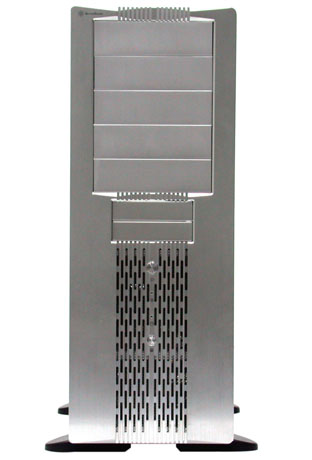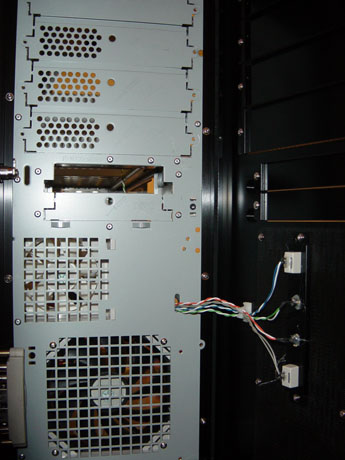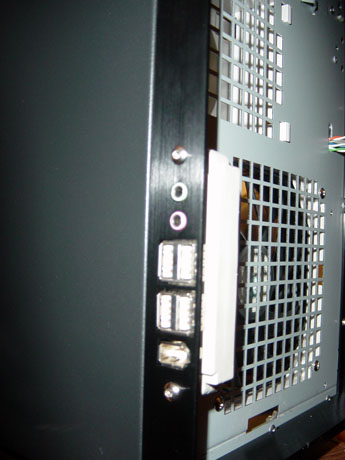SilverStone Technology Temjin 6: Another BTX Style in an ATX Form
by Purav Sanghani on September 25, 2004 12:05 AM EST- Posted in
- Cases/Cooling/PSUs
External Design
Most of SilverStone Technology's products have incorporated a sleek look - nothing too fancy or colorful, no themes like hideous spiders or masks on the front, and definitely, no unnecessary modding to make the product stand out in the market. We enjoy looking at a SilverStone Technology case because it doesn't hurt our eyes the way other cases have in the past.The bezel is designed with a monolithic façade, standing tall, yet in the simplest manner possible. The top half is composed of drive bays with matching black aluminum covers. There are five 5-1/4" bays and two 3-1/2" exposed bays on the bezel.
The bottom half of the Temjin 6 is composed of the power button and LED, the HDD activity LED, and the reset button positioned vertically down the middle in that exact order. Also placed vertically is a 3-inch wide grate, which aids in air circulation.
Again, the bezel features a clean look no matter what the color (black or silver), which makes the Temjin 6 stand out from the rest in a good way, like its predecessors, the Temjin III and Temjin V.
Moving to the left side, we see a few different features that were also implemented in the Temjin V. SilverStone has placed a key lock at mid height to lock the bezel door, which we will discuss later. Visually, the lock is implemented nicely and does not interfere with the rest of the visual features. Towards the bottom of the Temjin 6, on the same left side, are the auxiliary ports, which include color-coded head phone and microphone ports, a group of 4 USB ports, and a single FireWire port all lined up vertically. From the front of the case, they are not at all noticeable.
The rest of the outer shell continues the simplistic design with solid steel panels, leaving out windows and fans. The side panels use the sliding plastic clips to secure onto the case. We realized that these clips, if not taken care of, can be easily broken. There are holes cut out to secure the panels with screws in the traditional way, but a better design would have been to use thumbscrews instead.













28 Comments
View All Comments
karrock - Monday, September 27, 2004 - link
Has anyone tried an MSI K8N Neo2 Platinum in this case yet? The more I look at it, the more I think the "wind tunnel" won't work with its CPU placement. To further compound the issue, I'm cooling with an SLK-948U and 92mm fan.davegraham - Monday, September 27, 2004 - link
Also, i'd love to know how you can objectively measure dBa levels and temperature levels without a controlled environment? AFAIK, most manufacturers test with a zero-noise chamber for getting true readings on the actual levels of the case and an isolated thermal chamber with controlled temp/humidity to get real temperatures. I would have to say that the results from your testing, unless proven otherwise, are invalid and highly subjective.davegraham - Monday, September 27, 2004 - link
I'm curious as to what cases had "hideous spiders" on them? I've not seen one of those yet. I've been looking for a good theme case.slashbinslashbash - Sunday, September 26, 2004 - link
KK: My apologies. The 6 in "Temjin 6" was carried down to the next line on my screen, and I saw '6 12"' and read it as '6 1/2"', without connecting the 6 to the name of the case. In my confusion, I got carried away :) Thank you for clarifying things.KristopherKubicki - Sunday, September 26, 2004 - link
slashbinslashbash: Purav started using a Zalman HSF turned all the way down several reviews ago. He only compares those reviews with the same HSF/mobo/CPU setup. It runs in the 20dba range and does not significantly contribute to the sonic readings. Since all the cases use the same HSF it shouldn't matter anyway.All case reviews are measured from 12", including this review.
>Consistency in measurement is crucial in benchmarking. These things need to be measured exactly the same way every time, not in some ad-hoc fashion. These measurements need to be taken in the same room, with the door shut and the air conditioning turned off, with the case sitting on the same table (with no papers or other sound-absorbing material getting in the way), with the same components in it, with the same SPL meter at the same height and the same distance away from the front of the case. Every time.
They are.
Kristopher
slashbinslashbash - Sunday, September 26, 2004 - link
#12: This is a good question that needs to be answered. Purav has not been consistent. In the past, the cases have been tested with the PSU, CPU, and VGA fans off. This review only mentions turning off the PSU fan. Furthernore, in the Temjin 5 review (and elsewhere, e.g. Thermaltake Damier) the distance at which the sound level was measured was 12", not 6.5". Doubling the distance should theoretically result in 1/4 the sound intensity, i.e. 5-6dB lower. This would put the Temjin 6 near the top of the sound level performance chart.Consistency in measurement is crucial in benchmarking. These things need to be measured exactly the same way every time, not in some ad-hoc fashion. These measurements need to be taken in the same room, with the door shut and the air conditioning turned off, with the case sitting on the same table (with no papers or other sound-absorbing material getting in the way), with the same components in it, with the same SPL meter at the same height and the same distance away from the front of the case. Every time.
A single variation destroys the meaning of the benchmarks... we lose all basis for comparison between the cases. The dB numbers are no good on their own, just like 3DMarks. 44dB means nothing to me, as my case will be sitting on a carpeted floor at least 30 inches away from my ears and under a desk. However, knowledge that one case is quieter than another is useful and might impact my purchase.
T8000 - Sunday, September 26, 2004 - link
This case seems very noisy, like having to turn up the music volume to hear it above the case noise. Not to mention music with quiet passages, that will be unlistenable with such a noisy case.Was the sound measured with running CPU/NB/VGA fans?
If so, could you measure again with watercooling (Zalman Reserator or something) to isolate the case noise from the other components?
If not, could you run the fans at 7V and see how much that helps?
slashbinslashbash - Saturday, September 25, 2004 - link
#5, your comments are rubbish. It came in middle-of-the-pack on loudness, and the temps for other components (northbridge, southbridge, hard drive, etc.) were all comparable to the others, if not less than the others.Video cards are actively cooled, so that's not an issue. In fact, with the upside-down orientation of the motherboard (and therefore video card), this case should outperform all the others in this area. The video card heatsink will finally be facing up instead of down, so the heat can't pool on the underside of the card. Judging by the temps of the power supply, hard drives, etc. plenty of air is being moved through the top part of the case by the 80mm fan in front and the fans in the PSU. The hot air will rise up from the video card and be ejected by the PSU.
And all modern hard drives can be used in any orientation. Western Digital sells external drives with a vertical orientation, just to give one example. The voice coils that have been used in all hard drives for the past 15-20 years are so powerful that gravity is negligible.
Finally, I don't see how you can call the review itself rubbish. You may think that the case itself is rubbish because you have a few problems with it, but the review was nice and thorough IMO (except for the lack of video card temps).
devonz - Saturday, September 25, 2004 - link
In the article you mentioned concern for adequate video card cooling with this design, but then failed to ever tells how it performed. What's up with that? Some numbers would be nice :)Sabresiberian - Saturday, September 25, 2004 - link
Water cooling eliminates the need for a change in form factors and is hugely better.Weight is not an issue in a desktop system! Even if you carry your system around, the kind of weight differences we are talking about are negligible, and I would want the sturdiest case available not the lightest.